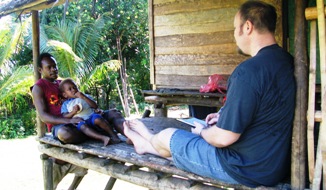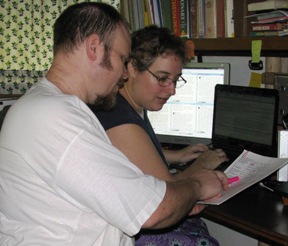
(From May 15th, 2011) Now it is my (Rick’s) turn to work on the passage for the next couple of steps in this long process. The first thing I do is a Content Check. I put the Content Check Draft up side by side with an essentially literal translation of the English Bible. I compare each verse in Lusi with the corresponding verse in English. I am checking to make sure that the full meaning of the portion has been transferred over. This is challenging as many times we can’t just substitute a Lusi word for an English word: there is not a one-to-one correlation as both languages see the world differently. I check the content because we don’t want to leave any meaning out, nor do we want to be adding in information that was not in the original. This takes some time, but it is very important because both mistakes can and do happen. I’m also doing my first proof-reading to catch things like missing words in the Lusi text and to make sure things like ‘person’ matches on the nouns and verbs.
After talking over my concerns and corrections with Anji, I then prepare for the next step, the Comprehension testing. I start by transferring the text file into a word processing template that I’ve made for this purpose. The Lusi Bible portion runs down the middle, the left side of the page contains my questions, and the right side has an extra wide blank margin for answers and any other notes. The questions I come up with on the left hand side are comprehension questions written in Lusi about the text, its meaning, and what happened in each ‘chunk’. I also go into the text and underline words and phrases that I want to get meanings for. Often, this is so I can be sure they are being understood correctly, but sometimes it is also for us the translators, so that we can be sure of the meaning of a word being used. Sometimes I circle words that I’d like acted out, again so that the proper meaning is being communicated. Once I’m done, Anji looks over it to see if there are any questions she wants added about things that need cleared up. Then I print off a copy and head to the village.
Each passage gets Comprehension Tested with at least three Lusi speakers. I sit down on a Translation Helper’s porch and read through the passage and ask them a few questions about the whole thing. After that, I go back and work through each chunk. Upon reading that chunk again, I ask specific questions about it. If it was particularly clear, or they are really into the story, then I usually don’t have to ask many questions because they can tell me all about the meaning of the chunk and what happened in it.
Once we’re through the questions we tackle the meanings of the words or phrases. This can be a real challenge sometimes because while we both know the meaning of what is being said, restating it in another language (especially an inadequate one like the trade language) can be difficult. And thus we work through the passage. I make any other notes like where we might need a little more work or a picture or a footnote. Each session I use a different color pen so by the time I’m done I can still keep track of who said what! The pages end up quite colorful.

Once the Comprehension Testing step is done, then it is time for a Corrections and Details step. Anji and I then sit down and create a Third Lusi Draft which contains the corrections, addition, deletions, and modifications. While these are not usually many, they are significant. Once in a while when one of our efforts to communicate something, particularly of a foreign nature, has really flopped, Anji will go back to the drawing board and start over on a piece of a passage. Then that portion has to go back through the Content and Comprehension steps all over again kind of like a “Do-not-pass-Go” card.
The for the next step, I take this new draft and verse by verse I do a Back To English (BTE) version of it, also know as a Back Translation (BT). My goal here is not to create a new English version (we probably don’t need any more of those), but rather, to be transparent to what the Lusi is saying. I want what is being communicated in Lusi to be apparent to anyone else reading it who doesn’t speak Lusi. This is very important for our Translation Consultant who will check this passage for us – because he doesn’t know any Lusi. Once I’ve done the BTE I try and let it rest overnight, then I check over it, proof-reading it and checking it against the essentially literal English Bible again. This can reveal places where information has been added or missed. Upon completion of this step, we send the BTE off to the Translation Consultant, but what happens after that, we don’t know yet. Once we do, we’ll let you all know!
Leave a Reply
You must be logged in to post a comment.